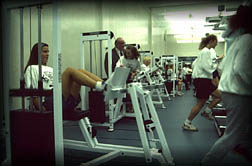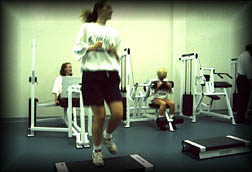


Catering to first time users, particularly women, within university weight rooms wasn't a priority on most college campuses five years ago. In 1991, the weight room at the University of Toronto at Mississauga (Erindale College) was typical of most campus weight rooms. Hidden on the basement floor with a small door way leading into a long narrow room, mirrored with a combination of free weights, benches and strength resistance machines crammed tightly with little room to either stretch or maneuver between equipment. The facility was anything but inviting. The room was occupied by men. Every few minutes a student, usually a woman, would appear at the door, take one step in, see the body builders, then immediately turn and walk out. The intimidation factor was very evident. A closer look at the demographics on campus showed that of the 6600 students at the university 62% were female. Cross referencing with the number of weight room users only 90 women (2% females) were registered compared to 850 men (34% male). Of the 90 women only 4 women had purchased a free weight user membership. The fact that the recreation program was not meeting the university's gender-equity obligations was obvious. Equally important was that by not addressing the needs of women and first-time users, a large fee pool with enormous revenue generation potential was left untapped.
The strategy taken to change the culture of our weight-room/fitness centre was as follows. Firstly, we totally relocated our weight room to a space with similar square footage in total area but was L-shaped. This configuration allowed for the placing of female friendly and popular cardio equipment (step machines, bikes, rowers) such that it could be viewed by the individual immediately upon coming in the door, whereas, the free weight area was less visible from the entrance creating a much less psychologically intimidating view for the first time user.

The greatest impact of the relocation was the culture change or atmosphere within the weight room. In the first month following these adjustments, the results were phenomenal. The total number of female users jumped to 363 women. In addition, over 150 new male users joined. We also increased our free-weight sales by over $3000 and recorded spin-off sales within our aerobic and other instruction programs. Over 50% of the total equipment investment was recovered in one month. Five years later, 750 female users enjoy the weight room and the number of men has expanded to over 900.
As a result, on an annual basis we have re-invested student moneys into the weight room. Improvements to the free weight equipment have been made, including the addition of duplicate sets of barbells and dumbbells, a smith machine and cable cross-over. Additional cardio equipment (treadmills and recumbent bikes) were also purchased.
Focusing on this strategy to improve the atmosphere and culture within the weight room for first-time users resulted in an opportunity to build a specialized facility for high performance weight training. This segregated the high performance powerlifters and Olympic weightlifters from the regular personal fitness users. In 1994, we created the University of Toronto at Mississauga Olympic Weightlifting Centre. The facility was housed in a former wrestling room which at that time was used only for storage. The only high performance centre of its kind within the Greater Toronto area, it houses four weightlifting platforms complete with Olympic Bars and rubberized plates. The room is supervised by two-time world Olympic weightlifting champion Antonio Krastev (formerly of Bulgaria) who coaches a variety of athletes in strength training; from the U of T at Mississauga Rowing crew, national high performance athletes and the Toronto Argonaut CFL Football team whom use the university campus as their practice facility. In addition, the facility is home for the Mississauga Special Olympics powerlifting team. By creating this dedicated facility it resulted in a win-win scenario for both the high performance athletes and the personal fitness users.

The last enhancement to the university's fitness centre was the completion of a 3500 square foot dedicated circuit training facility named "The Fit Stop". Learning from the experience of Guelph and McMaster Universities whom broke ground in offering this type of training, we saw the ability to popularize this method of training. This Circuit Training program is an ideal fitness program for all ages and fitness levels. The circuit, (Universal's Crossline) consists of 12 strength-resistance training stations combined with 12 aerobic step stations. Users move from resistance training units to step stations in timed intervals. The use of a countdown clock and light system easily structures the fitness program. 25 minutes in the Fit Stop and clients leave with a complete body work-out.
We saw not only large growth potential for our students, but also for our staff and faculty plus the opportunity to attract community and alumni members. The early results of this strategy are in. Within three weeks of "The Fit Stop" opening, over 45 staff and faculty have signed on and additional people have taken orientations. Staff and Faculty participation is important because studies have reported that social interaction between faculty and students outside the classroom is a major factor in student retention, as well as strengthening the bond between student and institution. The administration of the campus has also acknowledged the impact this program has had on improving staff morale. Community and alumni response has also been outstanding. All activity to date indicates quick cost recoveries with this initiative.
Focusing on the needs of women and first time users has brought about many benefits to the University of Toronto at Mississauga. The atmosphere and culture within the weight room has changed to make the facility more inviting. Investment in user friendly equipment has increased participation dramatically. This increased participation has created a substantial financial return. Although this strategy targeted the personal fitness user, the high performance athlete's training experience has been enhanced by having the financial resources to develop a dedicated weightlifting centre. Lastly, the Circuit Training facility, "The Fit Stop", provides users with a structured, self-monitored, results oriented workout. "The Fit Stop" rounds out the complement of training areas to service a wider range of users of all ages and fitness levels, increasing the attractiveness of the facility to other target markets (faculty, staff, alumni, and members of our community in general).
Over five short years these results were accomplished. By making your facility more inviting to women and first time users, you too can achieve similar success in a very short period of time.